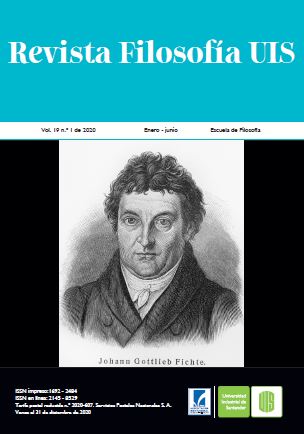Selection and archive from a critical approach to the relation between images and violence
Published 2020-01-01
Keywords
- Derrida,
- Images,
- Archive,
- Memory,
- Montage
- violence ...More
How to Cite
Copyright (c) 2020 Revista Filosofía UIS

This work is licensed under a Creative Commons Attribution 4.0 International License.
Abstract
This paper adds to the current debate about the strategies to show violence through the analysis of “The Last Night”, photobook recently published, and that is located in the context of the Colombian armed conflict of the second half of the XXth century. Since the topic of the memory becomes remarkably important for this discussion, we start from Jacques Derrida´s approach. This author, supported by Nietzsche, summons us to elaborate further on the relationship between archive and memory, examining the role of images thereof. According to him: a) memory is signed by the principle of ruin, of pollution, of untimeliness and of spectrality; b) the archive is not innocent, nor is it guided by the alleged objectivity of aesthetic disinterest, since it involves trimming and excluding, and implies relentless tensions and interpretative processes that appeal to the imposition mechanisms of an authority. From there we proceed to rebuild the conditions of a productive dialogue with other theoretical perspectives, as that of Walter Benjamin in the way of the interpretation suggested by George Didi-Huberman, with the purpose of enriching our comprehension of the quoted document.
Downloads
References
Benjamin, W. (2008). La obra de arte en la época de su reproductibilidad técnica. En Obras, libro I/Vol. II. Madrid: Abada.
Benjamin, W. (2010). El origen del Trauerspiel alemán. En Obras, libro I/Vol. I. Madrid: Abada.
Derrida, J. (1989). La escritura y la diferencia. (P. Peñalver, trad.). Barcelona: Anthropos.
Derrida, J. (1997). Mal de Archivo. Una impresión freudiana. Madrid: Trotta.
Derrida, J. y Stiegler, B. (1998). Ecografías de la Televisión. Entrevistas Filmadas. Buenos Aires: Eudeba.
Derrida, J. (2005). De la gramatología. (O. Del Barco y C. Cerreti, trads.). Ciudad de México: Siglo Veintiuno.
Derrida, J. (2013). Artes de lo visible (1979-2004). (J. Masó y J. Bassas, trads.). Castellón: El Lago Ediciones.
Díaz, J. M. (2018). Teoría mimética y América latina: el vigente problema de la identidad, un diálogo que nos convoca. Cuadernos de Filosofía Latinoamericana, 39(118), 143-158. DOI: https://doi.org/10.15332/25005375
Didi-Huberman, G. (1997). Lo que vemos, lo que nos mira. (H. Pons, trad.). Buenos Aires: Manantial.
Didi-Huberman, G. (2005). La venus rajada. Madrid: Losada.
Didi-Huberman, G. (2008). La emoción no dice ‘yo’. Diez fragmentos sobre la libertad estética. En Alfredo Jaar. La política de las imágenes. Santiago de Chile: Metales pesados.
Didi-Huberman, G. (2017). Sublevaciones. Buenos Aires: Untref.
Farocki, H. (2014). Desconfiar de las imágenes. Buenos Aires: Caja Negra.
Fisgativa, C. (2016). Lenguaje y alegoría. Modos de considerar el arte a partir de Walter Benjamin. Revista de filosofía UIS, 15(2), 137-155.
Freud, S. (1992). El yo y el ello y otras obras (1923-1925). En Obras completas, Tomo XIX. Buenos aires: Amorrortu.
Freud, S. (1993). Los textos fundamentales del psicoanálisis. Barcelona: Altaya.
Galtung, J. (2016). La violencia: cultural, estructural y directa. Cuadernos de estrategia, 183, 147-168.
Horta, J. (2018). La última noche. Bogotá: publicación independiente.
Nietzsche, F. (2009). La genealogía de la moral. Madrid: Alianza Editorial.
Masó, J. (2011). Illustrer, photographier, le point de suspension ou l’image chez Jacques Derrida. En J. Adnen (ed.), Derrida et la question de l’art, déconstructions de l’esthétique (pp. 361-383). Nantes: Éditions Cécile Defaut.
Plissart, M. F. y Derrida, J. (1985). Droit de regards. Paris: Minuit.
Rancière, J. (2009). El reparto de lo sensible. Estética y política. Santiago de Chile: LOM Ediciones.
Uribe, M. V. (2018). Los fantasmas no inquietan nunca a las cosas muertas: Entre el Terror y el desaliento en Colombia. Revista M, 3(5), 92-102.
Urueña, J. F. (2017). El montaje en Aby Warburg y en Walter Benjamin: un método alternativo para la representación de la violencia. Bogotá: Universidad del Rosario.
Warburg, A. (2013). La primavera de Boticelli. Madrid: Casimiro.
Žižek, S. (2018). Sobre la violencia. Barcelona: Paidós.
